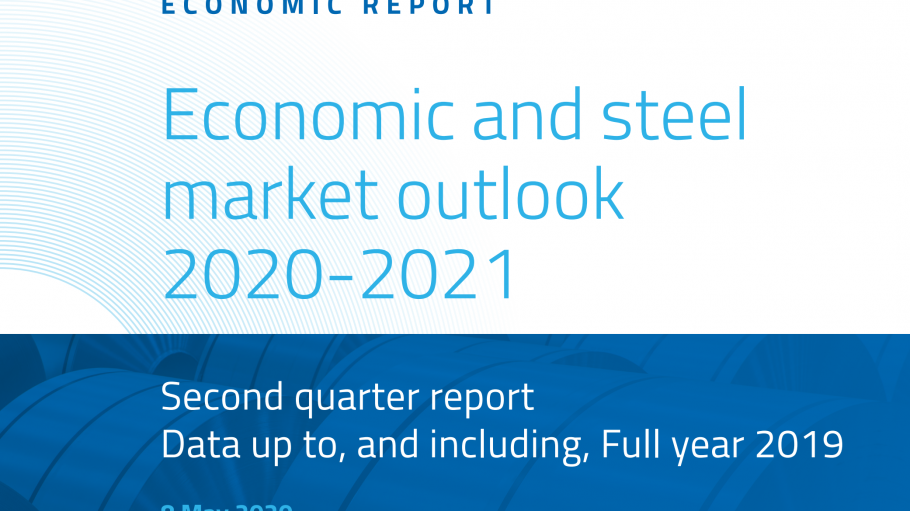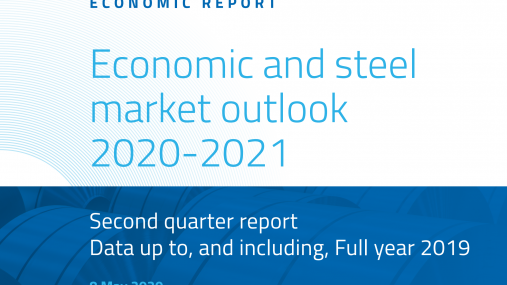
Publications » Economic and market outlook » Economic and steel market outlook 2020-2021, second quarter
Economic and steel market outlook 2020-2021, second quarter
Downloads and links
Recent updates

The COVID-19 outbreak across the EU and all world regions has slashed steel consumption forecasts as well as the overall economic outlook. Shutdown measures implemented by governments starting from March 2020 have hugely impacted manufacturing activity and steel-using industrial sectors. This has affected the automotive sector in particular, but it and other industries had already been experiencing subdued developments in the second half of 2019 due to the downslide of the manufacturing sector in the EU, escalating trade wars between the US and several of its main trading partners and persistent uncertainty regarding Brexit. All of these factors combined led to continued further deterioration in business sentiment and curbed investment growth throughout 2019, before the onset of the pandemic.
Actual data for apparent consumption reported here refers to the fourth quarter of 2019 and the whole year 2019, and therefore do not yet reflect the dramatic deterioration in economic prospects and steel consumption outlook that has materialised since March 2020. The outlook for this year and for 2021 is obviously particularly affected by the disruption caused by the pandemic and is likely to be revised significantly over the course of the year, depending on the length and magnitude of the crisis. The extension of the containment measures that have been put in place in EU Member States, the subsequent lockdown of industrial activity, and the unprecedented nature of this crisis, are not without consequence. Uncertainty and volatility surrounding possible developments in the coming months means no forecast could be considered reliable. EUROFER will temporarily not publish, in the context of its Economic and Market Outlook reports, figures quantifying its forecasts for 2020 and 2021.
Apparent steel consumption in the EU fell by -10.8% year-on-year in the fourth quarter of 2019, after a drop of 1.6% in the third quarter, resulting in yearly fall of -5.3% for the entire year 2019, that was the worst performance in EU steel demand since 2012. The negative trend in steel demand seen in the fourth quarter of 2019 is the result of the continued slump in EU’s manufacturing sector due to weakened exports and investment that has become more pronounced during the second half of last year, coupled with escalating trade tensions between the US and its major trading partners. Equally, data for the fourth quarter of 2019 continued to show growing import distortions as well as higher volatility as a result of the increase of safeguard measures’ quota.
The onset of the COVID-19 pandemic is expected to dramatically impact the already challenging steel market situation, with unprecedented consequences for the steel industry. Capacity idling, reduction in workforce and cuts in production are already taking place at an unprecedented scale and it is unknown, at the time of writing, as to when – or whether – normal economic activity will be fully restored. We assume that, according to confinement and lockdown easing schemes that have been set out by most EU governments, from the beginning of the third quarter production should have restarted again in almost all industrial sectors. The coming quarters will nevertheless be determined by some global restrictions on economic activity.

Download this publication or visit associated links
The outlook for the European steel market in 2024 continues to lose momentum amidst persisting challenging conditions. Downside factors such as worsening geopolitical tensions, coupled with growing economic uncertainty, energy prices, inflation, interest rates have further impacted demand prospects. According to EUROFER’s latest Economic and Steel Market Outlook, these challenges have exacerbated the negative effects on apparent steel consumption, resulting in a more severe downturn in 2023 than previously projected (-9%, instead of -6.3%) and weaker growth in 2024 (+3.2%, instead of +5.6%). Output in steel-using sectors, despite showing more resilience than expected in the past year (+1.1%), is now set to decline (-1%). Imports are once again on the rise (+11% in the last quarter of 2023), capturing a staggering 27% market share throughout 2023.
Second quarter 2024 report. Data up to, and including, fourth quarter 2023
Brussels, 22 March 2024 – The future of a strong and resilient EU can only be forged with steel made in Europe. Europe-made low-carbon steel has a strategic role as it enables a net-zero economy, but today it faces strong headwinds from high energy prices, unfair competition, global overcapacity and growing unilateral carbon costs. The year 2023 has recorded the lowest European crude steel production levels ever, with a number of idled plants and dire impact on workers. Ensuring the enabling conditions for the short-term viability and the decarbonisation of the steel sector urgently needs to be at the top of the EU agenda. This is the message delivered by the European Steel Association together with a number of high-level representatives of the sector on the occasion of the Clean Transition Dialogue on Steel in the presence of the Executive Vice Presidents of the European Commission, Maroš Šefčovič and Margrethe Vestager.